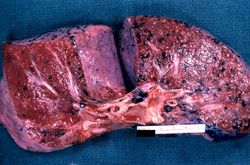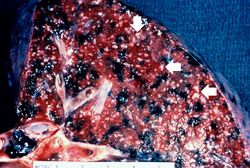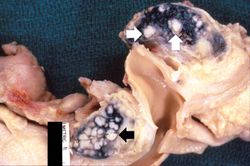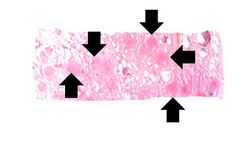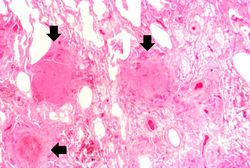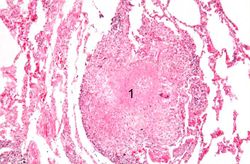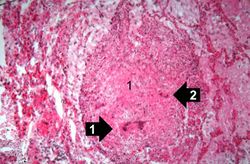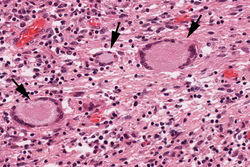IPLab:Lab 1:Tuberculosis
Contents
Clinical Summary[edit]
This 70-year-old man was admitted to the hospital with a history of upper abdominal pain, anorexia, nausea, and general malaise, all of approximately three weeks' duration. His hospital stay was characterized by fever and severe respiratory distress. There were multiple densities in the patient's chest x-ray consistent with pneumonia and examination of a stained sputum specimen showed acid fast bacilli. Despite intensive therapy, the patient progressively deteriorated and died 14 days after admission.
Autopsy Findings[edit]
It was determined at autopsy that the patient suffered from pulmonary tuberculosis with widespread dissemination throughout the body. The left lung weighed 620 grams and the right lung 1230 grams. These were characterized by marked pulmonary congestion and pulmonary edema. In addition, multiple gray-white nodules ranging from pinpoint size up to 1 cm were diffusely distributed throughout the lung parenchyma.
Images[edit]
This is a gross photograph of a cut section of lung from this patient with disseminated tuberculosis. The numerous small white nodules scattered throughout this lung tissue represent individual tuberculosis granulomas. In addition, note the dark areas throughout the lung which represent deposits of anthracotic pigment.
This gross photograph shows hilar lymph nodes from another patient with disseminated tuberculosis. The white, cheesy-appearing nodules (arrows) in the lymph nodes give rise to the descriptive terminology of caseous necrosis. The black pigment in the lymph nodes is anthracotic pigment that has drained from the lungs.
This is a low-power photomicrograph of a histology section from the lung of this patient with a chronic history of respiratory disease. Note the multiple eosinophilic nodules (arrows) seen at low power in this section. Other areas of the lung are relatively normal and several bronchi and large vessels can be seen at this low power. The pleural surface of the lung is at the left and the remaining edges are cut edges of the tissue block.
This photomicrograph shows a single nodule with an amorphous eosinophilic center and accumulations of cells around the outer edge. This is typical of a granuloma associated with tuberculosis in which there is a necrotic center (1) and a rim of lymphocytes, macrophages, and occasional multinucleated giant cells around the periphery.
This is a high-power photomicrograph of the Langhans-type multinucleated giant cell which is characteristic of tuberculous granulomas (arrow). Note the horseshoe shape of the nuclei in this giant cell. The majority of the cells in the upper left portion of this section are macrophages which provide the major cellular component in a granuloma. Note the smaller number of small blue-staining cells in the peripheral portions of this granuloma to the left of which are lymphocytes.
Study Questions[edit]
Additional Resources[edit]
Reference[edit]
- eMedicine Medical Library: Tuberculosis
- Merck Manual: Tuberculosis
- Centers for Disease Control: Tuberculosis
Journal Articles[edit]
- Lee MP, Chan JW, Ng KK, Li PC. Clinical manifestations of tuberculosis in HIV-infected patients. Respirology 2000 Dec;5(4):423-6.
Images[edit]
Related IPLab Cases[edit]
| |||||
In alcoholics, aspiration pneumonia is common--bacteria enter the lung via aspiration of gastric contents.
Acid fast bacilli are not easily decolorized by acid during staining. This is characteristic of mycobacteria.
A normal left lung weighs 375 grams (range: 325 to 480 grams).
A normal right lung weighs 450 grams (range: 360 to 570 grams.
Pulmonary congestion is the engorgement of pulmonary vessels with blood. The increased pressure caused by this engorgement leads to transudation of fluid through the capillary walls and into the alveolar and interstitial spaces.
Pulmonary edema refers to the accumulation of fluid in the pulmonary alveolar and tissue spaces as a result of changes in capillary permeability and/or increases in capillary hydrostatic pressure.
Disseminated tuberculosis refers to the hematogenous spread of tuberculous lesions throughout the body. It is also known as miliary tuberculosis (which is so-called because the lesions resemble millet).
A tuberculosis granuloma is a focus of granulomatous inflammation caused by CHRONIC tuberculosis infection. The granuloma consists of epithelioid cells (activated macrophages) surrounded by lymphocytes, plasma cells, and fibroblasts.
Anthracotic pigment is coal dust deposited in the lungs--it is seen in coal miners, city-dwellers, and smokers.
Disseminated tuberculosis refers to the hematogenous spread of tuberculous lesions throughout the body. It is also known as miliary tuberculosis (which is so-called because the lesions resemble millet).
Caseous means cheesy.
